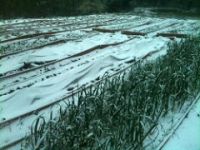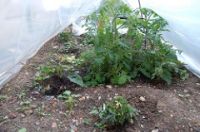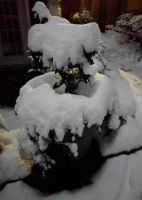Preparing Your Garden For Snowy Conditions
When you are a gardener, it is a good idea to be prepared for any eventuality. Forecasting can often give us a clue about upcoming weather, but forecasts are not always accurate, or course, and some weather systems can be rather surprising. If snow is forecast, in the winter or early in the spring, it is a good idea to prepare your garden so it is better able to cope when the snowy conditions arrive. Here are a few tips on what you should do if snow is forecast where you live (especially if the snow comes late in the winter or in early spring, when plants may already have begun to grow in your garden:
 Installing Row Covers & Horticultural Fleece
Installing Row Covers & Horticultural Fleece
If you have been blessed with a relatively mild winter then late snows can come as something of a shock. You may have rows of winter vegetables that have overwintered in the ground – kale, for example, or winter cabbages. If snow threatens, these vegetables can easily become ragged and damaged. Prevent this by installing row covers over your crops. Horticultural fleece can also be draped across a supporting structure and should be enough to keep the weight of the snow from crushing your crops as long as you don't get a huge accumulation.
 Using Cloches to Protect Tender Seedlings
Using Cloches to Protect Tender Seedlings
If the snows come particularly late, you may already have transplanted some seedlings to their final growing positions, or planted out half-hardy plants in your garden. If you have done so, you can often protect these seedlings and young plants from snow by covering them with cloches. Cloches can be bought, but you can also save money by making your own using plastic drinks bottles, plastic sheeting, or other similar items.
 Salting Paths and Patio Areas
Salting Paths and Patio Areas
For your own safety, if snow threatens, it is a good idea to make sure that you can still navigate your garden without slipping. Light snows and icy conditions can be combatted by sprinkling salt on your patio, steps and garden paths. This salt will reduce the likelihood of ice forming on the surfaces. If you are sprinkling salt however, remember to keep it well away from any of your growing areas, as it could be detrimental to plant health.
 Moving Container Plants & Tripping Hazards
Moving Container Plants & Tripping Hazards
Any containers that have been moved outdoors for the spring should of course be moved back into a protected environment or indoors when a late snow is forecast. It could also be a good idea, if heavy snow is expected, to move containers and other tripping hazards out of the way, to make it easier for you to navigate your garden safely when it is blanketed under a thick layer of snow.
Simple measures taken ahead of time can save you more time and effort when the snow recedes. A gardener should always be one step ahead of the weather as often as that is possible.